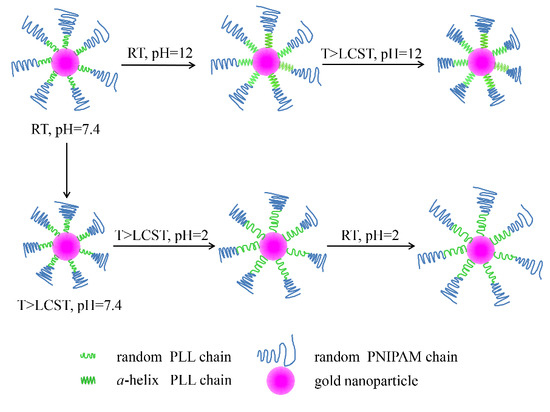Gold Nanoparticles Grafted with PLL-b-PNIPAM: Interplay on Thermal/pH Dual-Response and Optical Properties
Abstract
:1. Introduction
2. Results and Discussion
2.1. Preparation of PNIPAM-PLL-AuNPs
2.2. Comparison of the Stability of AuNPs Protected by PNIPAM-PLL Copolymer and PLL Homopolymer
2.3. Comparison of PLL Conformation between before and after Its Attachment onto AuNPs
2.4. Dual pH- and Temperature-Response of PNIPAM-PLL-AuNPs Monitored with Optical Transmittance
2.5. Alteration of Surface Plasmon Resonance of PNIPAM-PLL-AuNPs with pH Value
2.6. Alteration of Surface Plasmon Resonance of PNIPAM-PLL-AuNPs with Temperature
3. Materials and Methods
3.1. Materials
3.2. Synthesis of PNIPAM-b-PLL Copolymer
3.3. Synthesis and Functionalization of Gold Nanoparticles
3.4. Characterization
4. Conclusions
Acknowledgments
Author Contributions
Conflicts of Interest
References
- Hayat, M.A. (Ed.) Colloid Gold: Principles, Methods, and Applications; Academic Press: San Diego, CA, USA, 1989; Volume 1. [Google Scholar]
- Kreibig, U.; Vollmer, M. Optical Properties of Metal Clusters; Springer: Berlin, Germany, 1995. [Google Scholar]
- Shipway, A.N.; Katz, E.; Willner, I. Nanoparticle arrays on surfaces for electronic, optical, and sensor applications. ChemPhysChem 2000, 1, 18–52. [Google Scholar] [CrossRef]
- Adams, D.M.; Brus, L.; Chidsey, C.E.D.; Creager, S.; Creutz, C.; Kagan, C.R.; Kamat, P.V.; Lieberman, M.; Lindsay, S.; Marcus, R.A.; et al. Charge transfer on the nanoscale: Current status. J. Phys. Chem. B 2003, 107, 6668–6697. [Google Scholar] [CrossRef]
- Daniel, M.C.; Astruc, D. Gold nanoparticles: Assembly, supramolecular chemistry, quantum-size-related properties, and applications toward biology, catalysis, and nanotechnology. Chem. Rev. 2004, 104, 293–346. [Google Scholar] [CrossRef] [PubMed]
- Corti, C.W.; Holliday, R.J. Commercial aspects of gold applications: From materials science to chemical science. Gold Bull. 2004, 37, 20–26. [Google Scholar] [CrossRef]
- Feldheim, D.L.; Keating, C.D. Self-assembly of single electron transistors and related devices. Chem. Soc. Rev. 1998, 27, 1–12. [Google Scholar] [CrossRef]
- Maier, S.A.; Brongersma, M.L.; Kik, P.G.; Meltzer, S.; Requicha, A.A.G.; Atwater, H.A. Plasmonics—A route to nanoscale optical devices. Adv. Mater. 2001, 13, 1501–1505. [Google Scholar] [CrossRef]
- Kesharwani, P.; Jain, K.; Jain, N.K. Dendrimer as nanocarrier for drug delivery. Prog. Polym. Sci. 2014, 39, 268–307. [Google Scholar] [CrossRef]
- Marcelo, G.; Munoz-Bonilla, A.; Fernandez-Garcia, M. Magnetite-Polypeptide Hybrid Materials Decorated with Gold Nanoparticles: Study of Their Catalytic Activity in 4-Nitrophenol Reduction. J. Phys. Chem. C 2012, 116, 24717–24725. [Google Scholar] [CrossRef]
- Brust, M.; Walker, M.; Bethell, D.; Schiffrin, D.J.; Whyman, R. Synthesis of Thiol-Derivatized Gold Nanoparticles in a 2-Phase Liquid-Liquid System. J. Chem. Soc. Chem. Commun. 1994, 7, 801–802. [Google Scholar] [CrossRef]
- Templeton, A.C.; Wuelfing, M.P.; Murray, R.W. Monolayer protected cluster molecules. Acc. Chem. Res. 2000, 33, 27–36. [Google Scholar] [CrossRef] [PubMed]
- Zhou, Y.; Itoh, H.; Uemura, T.; Naka, K.; Chujo, Y. Synthesis of novel stable nanometer-sized metal (M = Pd, Au, Pt) colloids protected by a π-conjugated polymer. Langmuir 2002, 18, 277–283. [Google Scholar] [CrossRef]
- Mossmer, S.; Spatz, J.P.; Moller, M.; Aberle, T.; Schmidt, J.; Burchard, W. Solution behavior of poly(styrene)-block-poly(2-vinylpyridine) micelles containing gold nanoparticles. Macromolecules 2000, 33, 4791–4798. [Google Scholar] [CrossRef]
- Miyazaki, A.; Nakano, Y. Morphology of platinum nanoparticles protected by poly(N-isopropylacrylamide). Langmuir 2000, 16, 7109–7111. [Google Scholar] [CrossRef]
- De la Fuente, J.M.; Barrientos, A.G.; Rojas, T.C.; Rojo, J.; Canada, J.; Fernandez, A.; Penades, S. Gold glyconanoparticles as water-soluble polyvalent models to study carbohydrate interactions. Angew. Chem. Int. Ed. 2001, 40, 2258–2321. [Google Scholar] [CrossRef]
- Cao, Y.W.; Jin, R.; Mirkin, C.A. DNA-modified core-shell Ag/Au nanoparticles. J. Am. Chem. Soc. 2001, 123, 7961–7962. [Google Scholar] [CrossRef] [PubMed]
- Bartz, M.; Kuther, J.; Nelles, G.; Weber, N.; Seshadri, R.; Tremel, W. Monothiols derived from glycols as agents for stabilizing gold colloids in water: Synthesis, self-assembly and use as crystallization templates. J. Mater. Chem. 1999, 9, 1121–1125. [Google Scholar] [CrossRef]
- Liu, J.; Ong, W.; Roman, E.; Lynn, M.J.; Kaifer, A.E. Cyclodextrin-modified gold nanospheres. Langmuir 2000, 16, 3000–3002. [Google Scholar] [CrossRef]
- Thomas, K.G.; Kamat, P.V. Making gold nanoparticles glow: Enhanced emission from a surface-bound fluoroprobe. J. Am. Chem. Soc. 2000, 122, 2655–2656. [Google Scholar] [CrossRef]
- Hostetler, M.J.; Murray, R.W. Colloids and self-assembled monolayers. Curr. Opin. Colloid Interface Sci. 1997, 2, 42–50. [Google Scholar] [CrossRef]
- Hostetler, M.J.; Green, S.J.; Stokes, J.J.; Murray, R.W. Monolayers in three dimensions: Synthesis and electrochemistry of ω-functionalized alkanethiolate-stabilized gold cluster compounds. J. Am. Chem. Soc. 1996, 118, 4212–4213. [Google Scholar] [CrossRef]
- Nuopponen, M.; Tenhu, H. Gold nanoparticles protected with pH and temperature-sensitive diblock copolymers. Langmuir 2007, 23, 5352–5357. [Google Scholar] [CrossRef] [PubMed]
- Li, L.Y.; He, W.D.; Li, W.T.; Zhang, K.R.; Pan, T.T.; Ding, Z.L.; Zhang, B.Y. Thermal and pH-sensitive gold nanoparticles from H-shaped block copolymers of (PNIPAM/PDMAEMA)-b-PEG-b-(PNIPAM/PDMAEMA). J. Polym. Sci. Part A Polym. Chem. 2010, 48, 5018–5029. [Google Scholar] [CrossRef]
- Song, L.C.; Sun, H.; Chen, X.L.; Han, X.; Liu, H.L. From multi-responsive tri- and diblock copolymers to diblock-copolymer-decorated gold nanoparticles: The effect of architecture on micellization behaviors in aqueous solutions. Soft Matter 2015, 11, 4830–4839. [Google Scholar] [CrossRef] [PubMed]
- Kuila, A.; Maity, N.; Chatterjee, D.P.; Nandi, A.K. pH and Temperature Responsiveness in AgNPs Stabilized by a New Poly(Vinylidene Fluoride) Random Graft Copolymer. J. Polym. Sci. Pol. Chem. 2017, 55, 960–970. [Google Scholar] [CrossRef]
- Kitayama, Y.; Takeuchi, T. Localized Surface Plasmon Resonance Nanosensing of C-Reactive Protein with Poly(2-methacryloyloxyethyl phosphorylcholine)-Grafted Gold Nanoparticles Prepared by Surface-Initiated Atom Transfer Radical Polymerization. Anal. Chem. 2014, 86, 5587–5594. [Google Scholar] [CrossRef] [PubMed]
- Wang, Z.Z.; Chen, Z.W.; Liu, Z.; Shi, P.; Dong, K.; Ju, E.G.; Ren, J.S.; Qu, X.G. A multi-stimuli responsive gold nanocage-hyaluronic platform for targeted photothermal and chemotherapy. Biomaterials 2014, 35, 9678–9688. [Google Scholar] [CrossRef] [PubMed]
- Aioub, M.; El-Sayed, M.A. A Real-Time Surface Enhanced Raman Spectroscopy Study of Plasmonic Photothermal Cell Death Using Targeted Gold Nanoparticles. J. Am. Chem. Soc. 2016, 138, 1258–1264. [Google Scholar] [CrossRef] [PubMed]
- Davidson, B.; Fasman, G.D. Conformational Transitions of Uncharged Poly-l-Lysine. α Helix-Random Coil-β Structure. Biochemistry 1967, 6, 1616–1629. [Google Scholar] [CrossRef] [PubMed]
- Greenfie, N.; Fasman, G.D. Computed Circular Dichroism Spectra for Evaluation of Protein Conformation. Biochemistry 1969, 8, 4108–4116. [Google Scholar] [CrossRef]
- Guo, Y.; Xia, F.; Xu, L.; Li, J.; Yang, W.S.; Jiang, L. Switchable Wettability on Cooperative Dual-Responsive Poly-l-lysine Surface. Langmuir 2010, 26, 1024–1028. [Google Scholar] [CrossRef] [PubMed]
- Chen, L.L.; Chen, T.; Fang, W.X.; Wen, Y.; Lin, S.L.; Lin, J.P.; Cai, C.H. Synthesis and pH-Responsive “Schizophrenic” Aggregation of a Linear-Dendron-Like Polyampholyte Based on Oppositely Charged Polypeptides. Biomacromolecules 2013, 14, 4320–4330. [Google Scholar] [CrossRef] [PubMed]
- Malinsky, M.D.; Kelly, K.L.; Schatz, G.C.; Van Duyne, R.P. Chain length dependence and sensing capabilities of the localized surface plasmon resonance of silver nanoparticles chemically modified with alkanethiol self-assembled monolayers. J. Am. Chem. Soc. 2001, 123, 1471–1482. [Google Scholar] [CrossRef]
- Li, L.Y.; He, W.D.; Li, J.A.; Zhang, B.Y.; Pan, T.T.; Sun, X.L.; Ding, Z.L. Shell-Cross-Linked Micelles from PNIPAM-b-(PLL)(2) Y-Shaped Miktoarm Star Copolymer as Drug Carriers. Biomacromolecules 2010, 11, 1882–1890. [Google Scholar] [CrossRef] [PubMed]
- Xu, L.; Guo, Y.; Xie, R.G.; Zhuang, J.Q.; Yang, W.S.; Li, T.J. Three-dimensional assembly of Au nanoparticles using dipeptides. Nanotechnology 2002, 13, 725–728. [Google Scholar] [CrossRef]
- Shen, W.L.; Qu, Y.Y.; Pei, X.F.; Li, S.Z.; You, S.N.; Wang, J.W.; Zhang, Z.J.; Zhou, J.T. Catalytic reduction of 4-nitrophenol using gold nanoparticles biosynthesized by cell-free extracts of Aspergillus sp. WL-Au. J. Hazard Mater. 2017, 321, 299–306. [Google Scholar] [CrossRef] [PubMed]
- Dutt, S.; Siril, P.F.; Sharma, V.; Periasamy, S. Gold(core)-polyaniline(shell) composite nanowires as a substrate for surface enhanced Raman scattering and catalyst for dye reduction. New J. Chem. 2015, 39, 902–908. [Google Scholar] [CrossRef]
- Smirnovas, V.; Winter, R.; Funck, T.; Dzwolak, W. Thermodynamic properties underlying the α-helix-to-β-sheet transition, aggregation, and amyloidogenesis of polylysine as probed by calorimetry, densimetry, and ultrasound velocimetry. J. Phys. Chem. B 2005, 109, 1904–19045. [Google Scholar] [CrossRef] [PubMed]
- Dzwolak, W.; Muraki, T.; Kato, M.; Taniguchi, Y. Chain-length dependence of α-helix to β-sheet transition in polylysine: Model of protein aggregation studied by temperature-tuned FTIR spectroscopy. Biopolymers 2004, 73, 463–469. [Google Scholar] [CrossRef] [PubMed]
- Rao, J.Y.; Zhang, Y.F.; Zhang, J.Y.; Liu, S.Y. Facile Preparation of Well-Defined AB(2) Y-Shaped Miktoarm Star Polypeptide Copolymer via the Combination of Ring-Opening Polymerization and Click Chemistry. Biomacromolecules 2008, 9, 2586–2593. [Google Scholar] [CrossRef] [PubMed]
- Li, T.H.; Park, H.G.; Lee, H.S.; Choi, S.H. Circular dichroism study of chiral biomolecules conjugated nanoparticles. Nanotechnology 2004, 15, S660–S663. [Google Scholar] [CrossRef]
- Xia, Y.; Burke, N.A.D.; Stover, H.D.H. End group effect on the thermal response of narrow-disperse poly(N-isopropylacrylamide) prepared by atom transfer radical polymerization. Macromolecules 2006, 39, 2275–2283. [Google Scholar] [CrossRef]
- Wang, W.; Wan, W.; Zhou, H.H.; Niu, S.Q.; Li, A.D.Q. Alternating DNA and π-conjugated sequences. Thermophilic foldable polymers. J. Am. Chem. Soc. 2003, 125, 5248–5249. [Google Scholar] [CrossRef] [PubMed]
- Wang, W.; Han, J.J.; Wang, L.Q.; Li, L.S.; Shaw, W.J.; Li, A.D.Q. Dynamic π-π stacked molecular assemblies emit from green to red colors. Nano Lett. 2003, 3, 455–458. [Google Scholar] [CrossRef]
- Wang, W.; Li, L.S.; Helms, G.; Zhou, H.H.; Li, A.D.Q. To fold or to assemble? J. Am. Chem. Soc. 2003, 125, 1120–1121. [Google Scholar] [CrossRef] [PubMed]
- Liz-Marzan, L.M. Tailoring surface plasmons through the morphology and assembly of metal nanoparticles. Langmuir 2006, 22, 32–41. [Google Scholar] [CrossRef] [PubMed]
- Templeton, A.C.; Pietron, J.J.; Murray, R.W.; Mulvaney, P. Solvent refractive index and core charge influences on the surface plasmon absorbance of alkanethiolate monolayer-protected gold clusters. J. Phys. Chem. B 2000, 104, 564–570. [Google Scholar] [CrossRef]
- Ghosh, S.K.; Nath, S.; Kundu, S.; Esumi, K.; Pal, T. Solvent and ligand effects on the localized surface plasmon resonance (LSPR) of gold colloids. J. Phys. Chem. B 2004, 108, 13963–13971. [Google Scholar] [CrossRef]
- Heath, J.R.; Knobler, C.M.; Leff, D.V. Pressure/temperature phase diagrams and superlattices of organically functionalized metal nanocrystal monolayers: The influence of particle size, size distribution, and surface passivant. J. Phys. Chem. B 1997, 101, 189–197. [Google Scholar] [CrossRef]
- Collier, C.P.; Saykally, R.J.; Shiang, J.J.; Henrichs, S.E.; Heath, J.R. Reversible tuning of silver quantum dot monolayers through the metal-insulator transition. Science 1997, 277, 1978–1981. [Google Scholar] [CrossRef]
- Yusa, S.I.; Fukuda, K.; Yamamoto, T.; Iwasaki, Y.; Watanabe, A.; Akiyoshi, K.; Morishima, Y. Salt effect on the heat-induced association Behavior of gold nanoparticles coated with Poly(N-isopropylacrylamide) prepared via reversible addition—Fragmentation chain transfer (RAFT) radical polymerization. Langmuir 2007, 23, 12842–12848. [Google Scholar] [CrossRef] [PubMed]
- Ciampoli, M.; Nardi, N. 5-Coordinated High-Spin Complexes of Bivalent Cobalt Nickel and Copper with Tris(2-Dimethylaminoethyl)Amine. Inorg. Chem. 1966, 5, 41–44. [Google Scholar] [CrossRef]
- Grabar, K.C.; Freeman, R.G.; Hommer, M.B.; Natan, M.J. Preparation and Characterization of Au Colloid Monolayers. Anal. Chem. 1995, 67, 735–743. [Google Scholar] [CrossRef]
Sample Availability: Not available. |
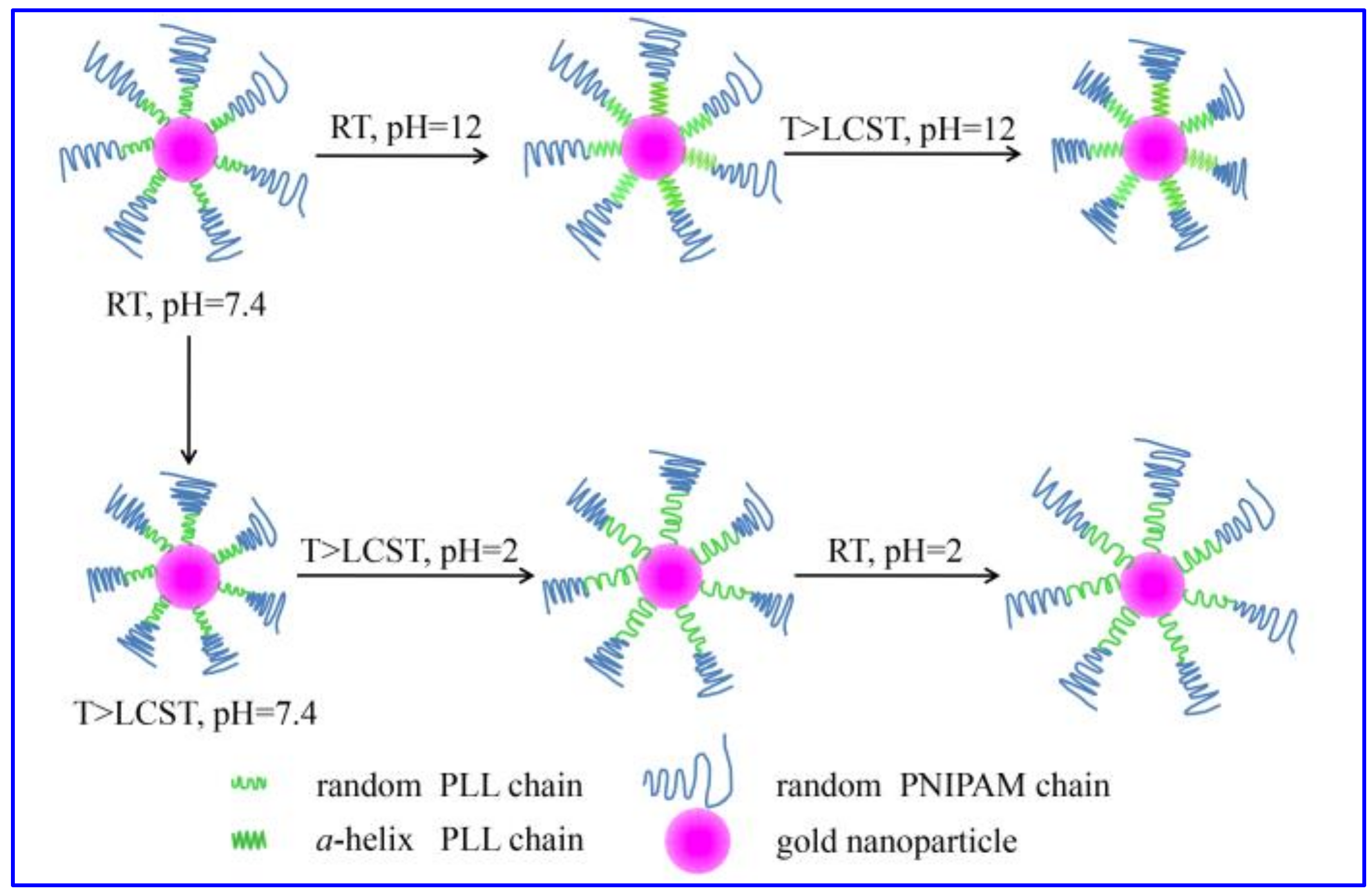
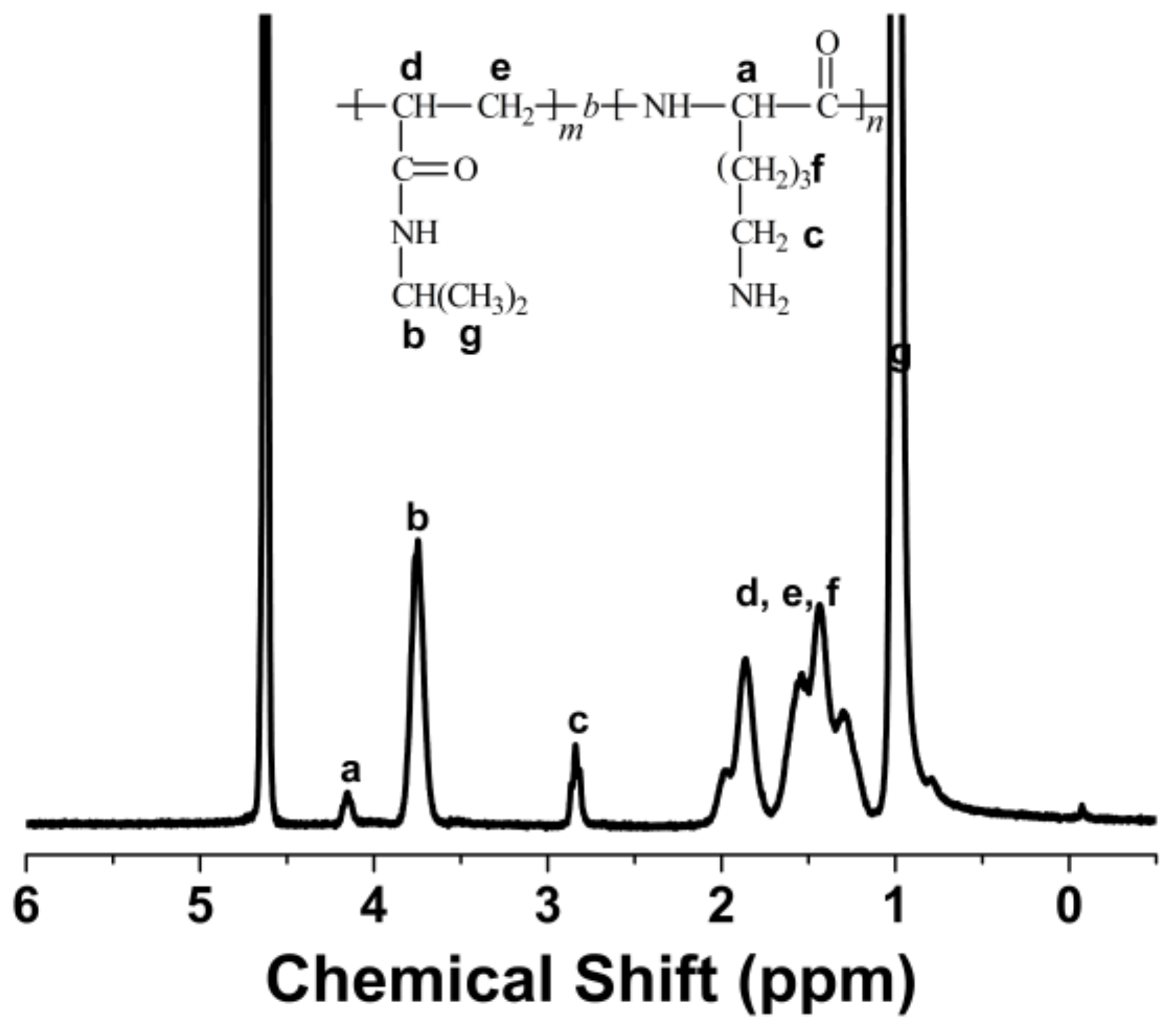
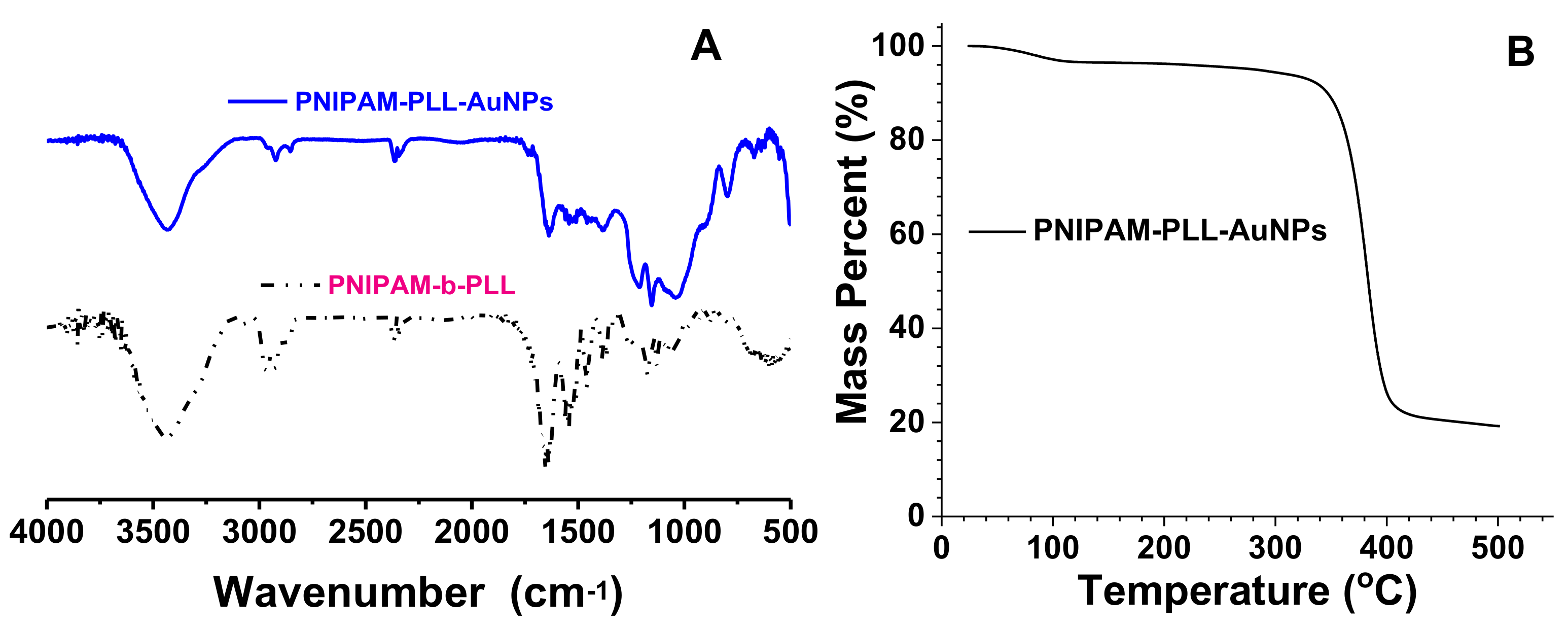
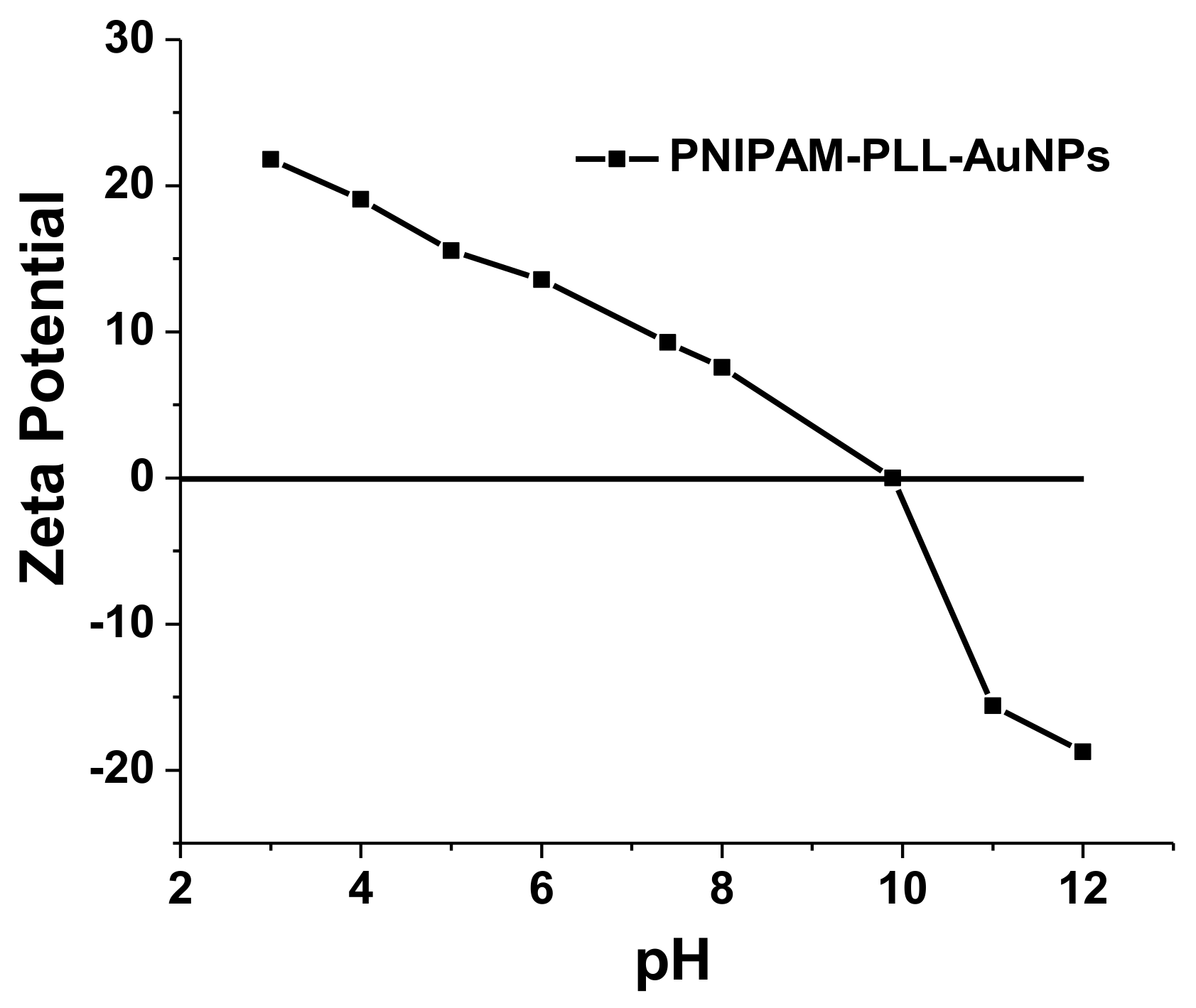
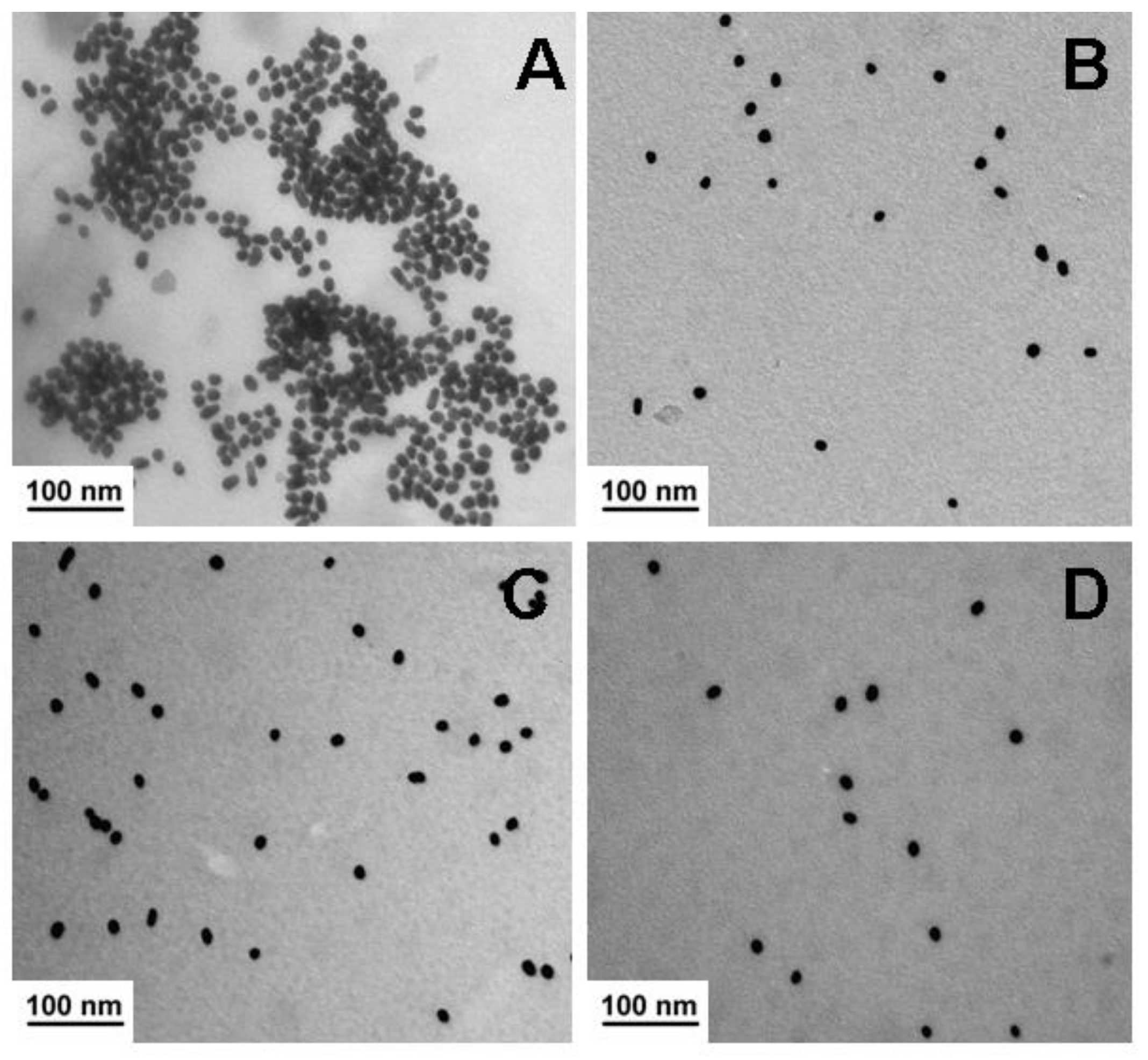
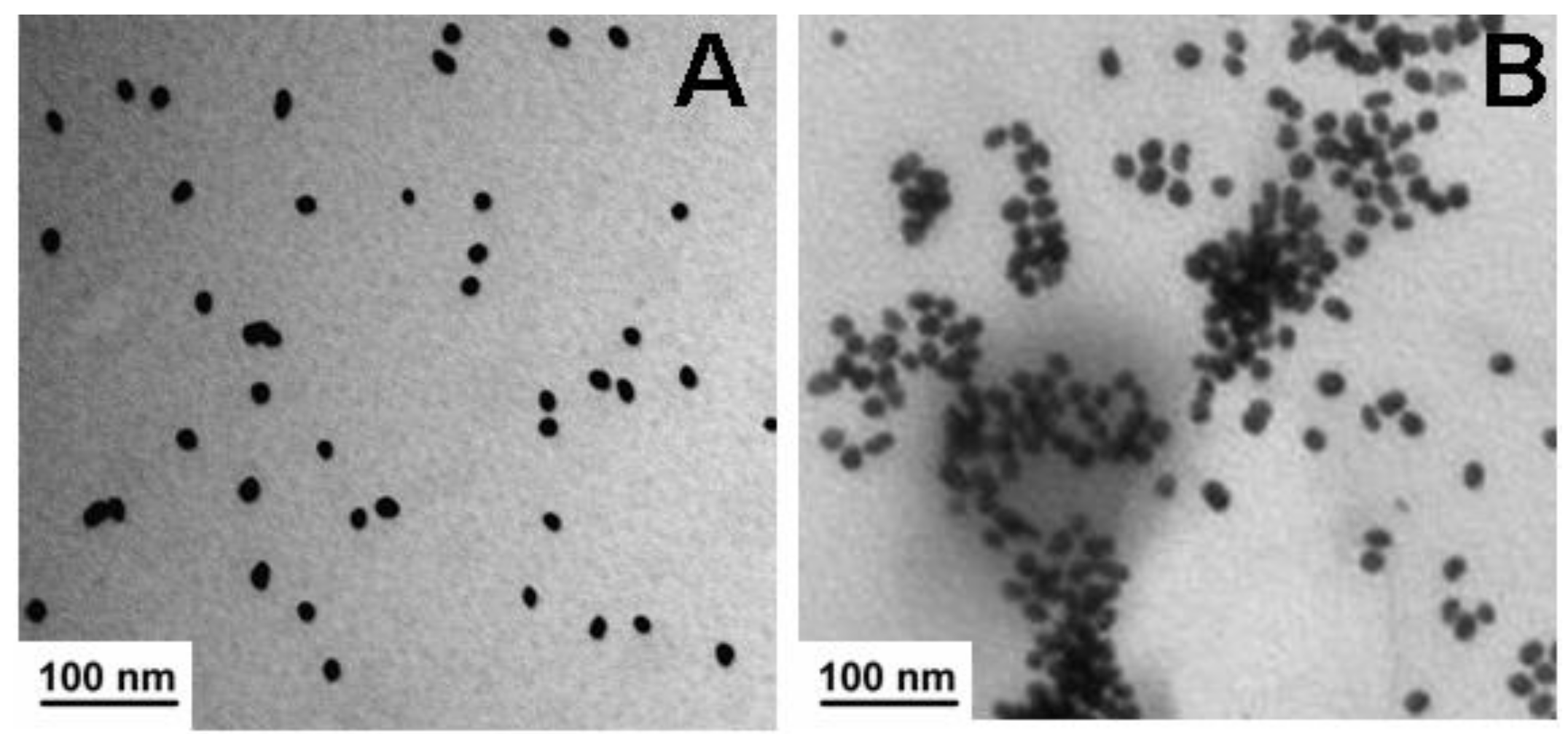
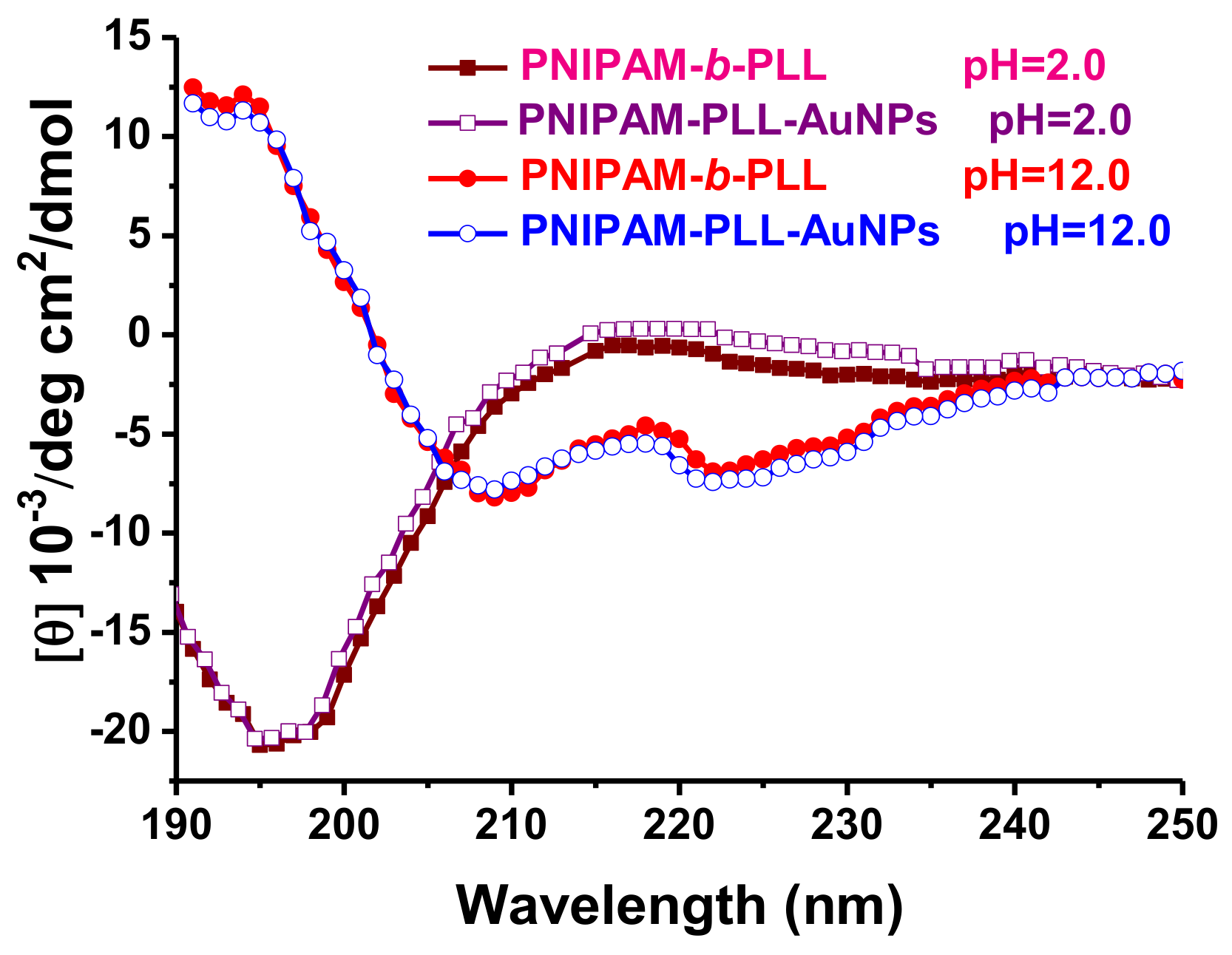
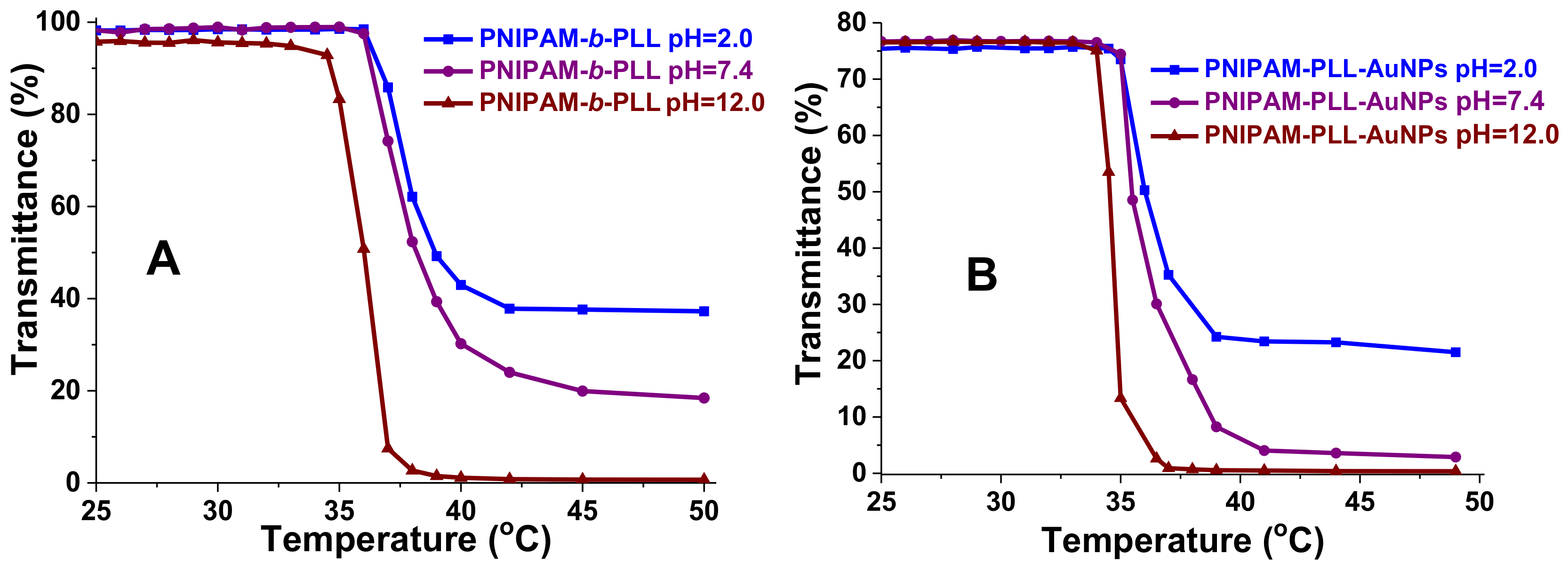
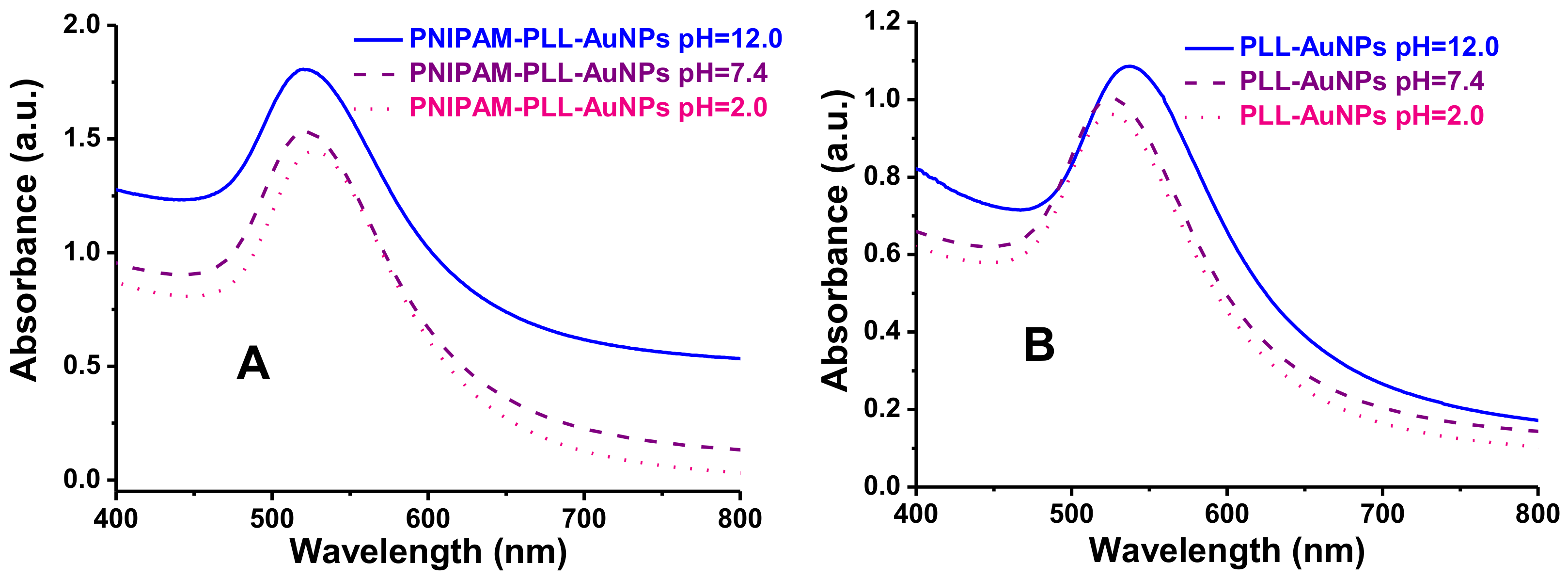
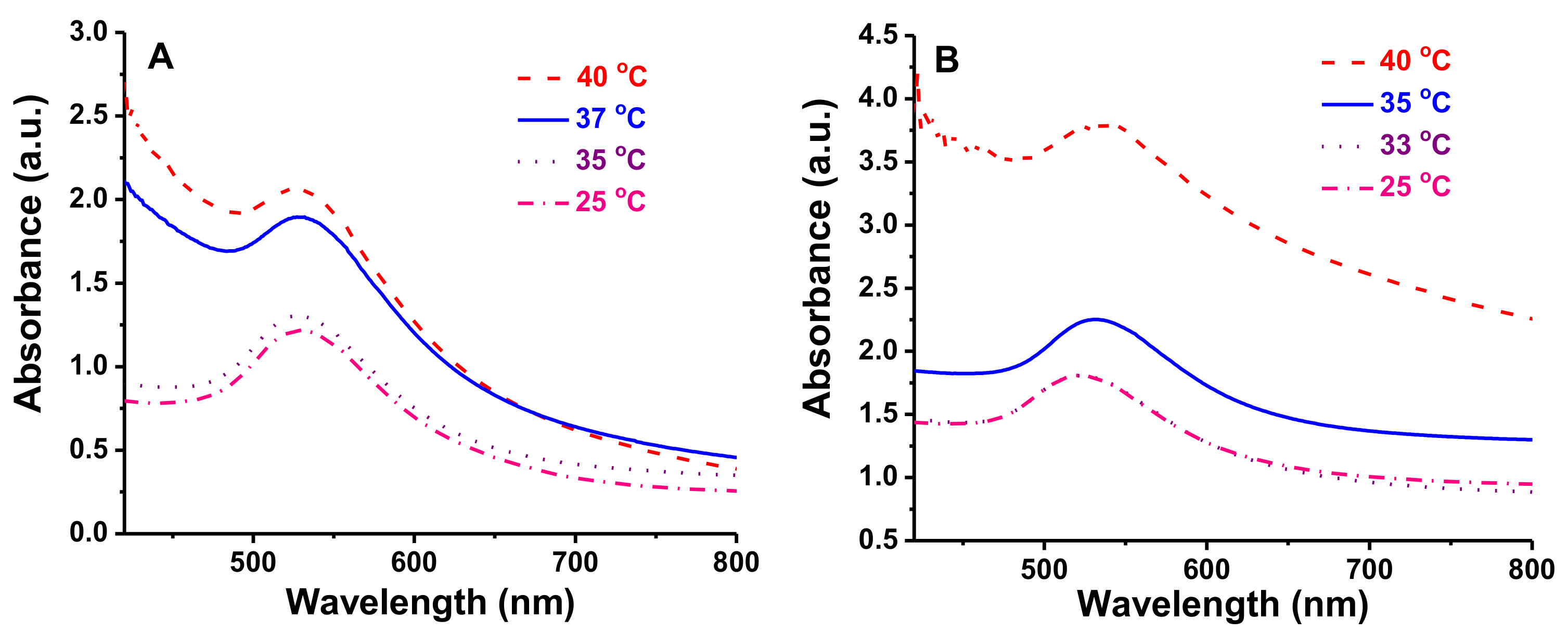
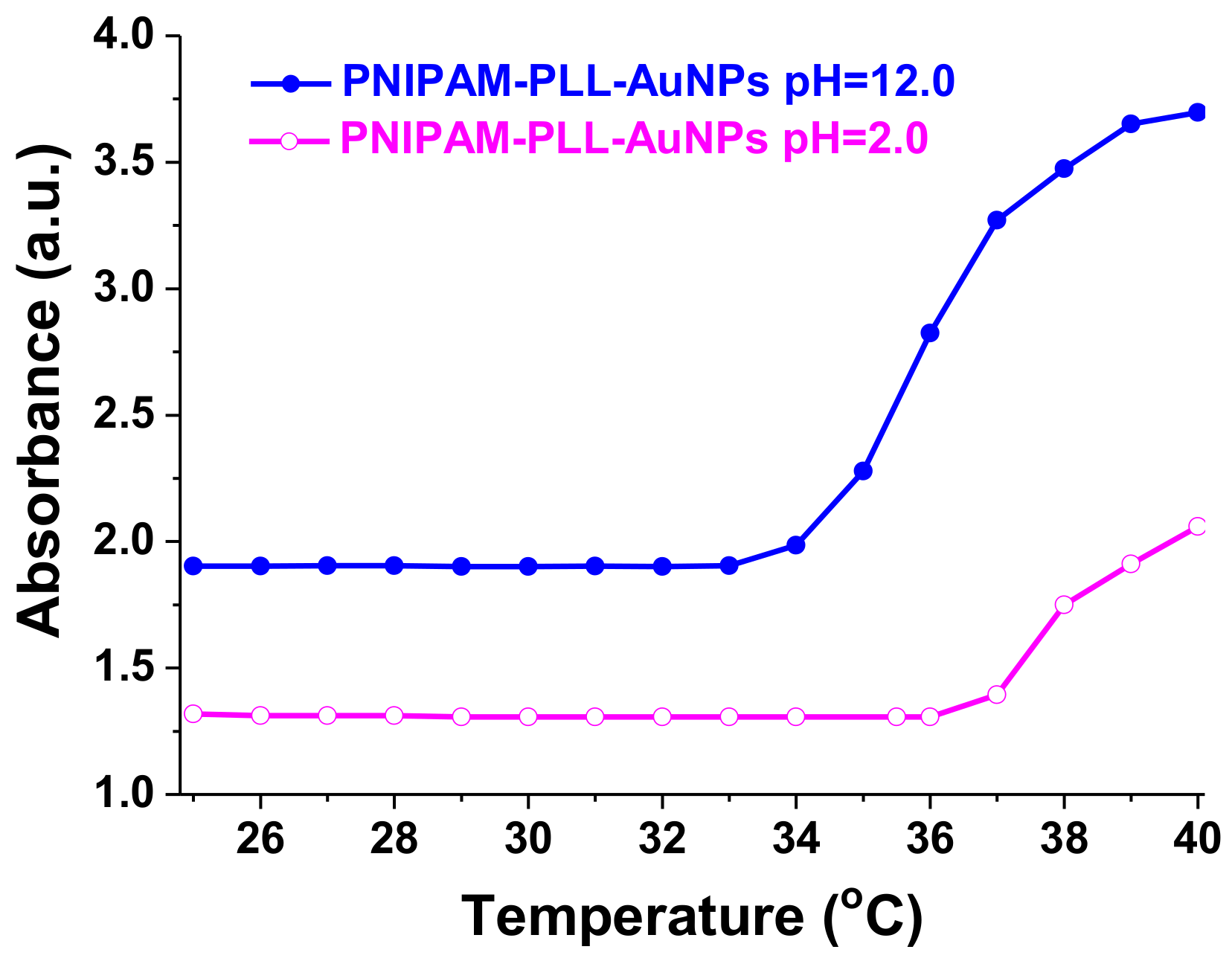
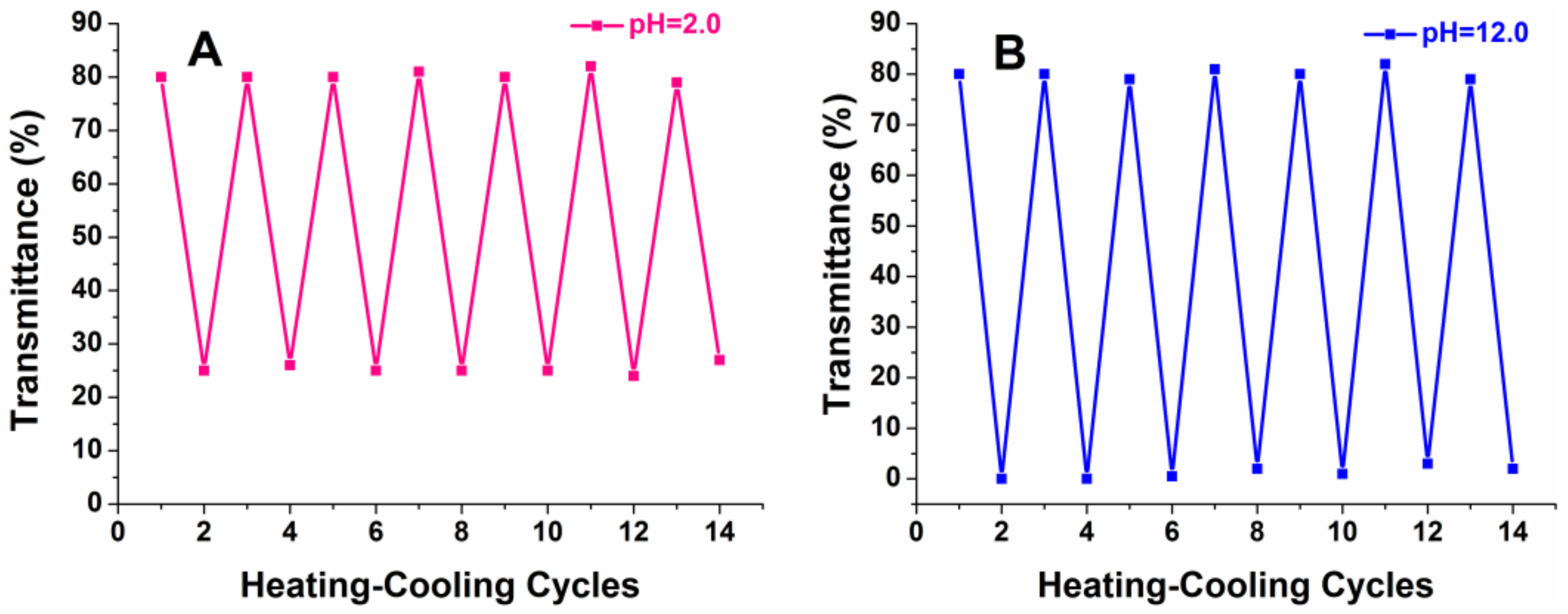
© 2018 by the authors. Licensee MDPI, Basel, Switzerland. This article is an open access article distributed under the terms and conditions of the Creative Commons Attribution (CC BY) license (http://creativecommons.org/licenses/by/4.0/).
Share and Cite
Li, H.-J.; Li, P.-Y.; Li, L.-Y.; Haleem, A.; He, W.-D. Gold Nanoparticles Grafted with PLL-b-PNIPAM: Interplay on Thermal/pH Dual-Response and Optical Properties. Molecules 2018, 23, 921. https://doi.org/10.3390/molecules23040921
Li H-J, Li P-Y, Li L-Y, Haleem A, He W-D. Gold Nanoparticles Grafted with PLL-b-PNIPAM: Interplay on Thermal/pH Dual-Response and Optical Properties. Molecules. 2018; 23(4):921. https://doi.org/10.3390/molecules23040921
Chicago/Turabian StyleLi, Hui-Juan, Peng-Yun Li, Li-Ying Li, Abdul Haleem, and Wei-Dong He. 2018. "Gold Nanoparticles Grafted with PLL-b-PNIPAM: Interplay on Thermal/pH Dual-Response and Optical Properties" Molecules 23, no. 4: 921. https://doi.org/10.3390/molecules23040921
APA StyleLi, H.-J., Li, P.-Y., Li, L.-Y., Haleem, A., & He, W.-D. (2018). Gold Nanoparticles Grafted with PLL-b-PNIPAM: Interplay on Thermal/pH Dual-Response and Optical Properties. Molecules, 23(4), 921. https://doi.org/10.3390/molecules23040921





